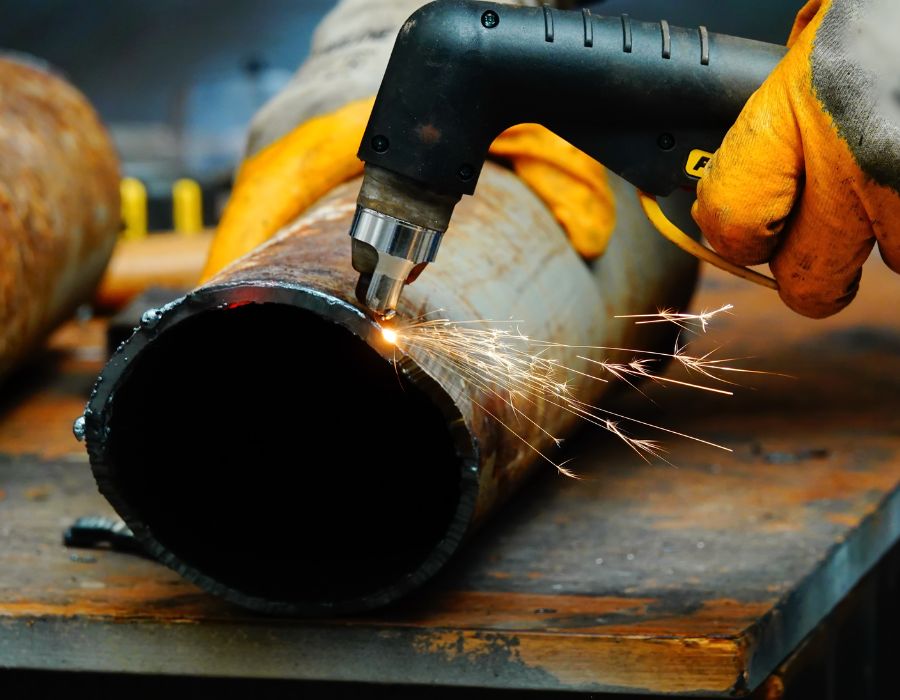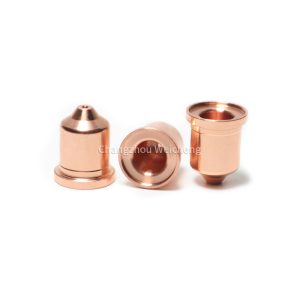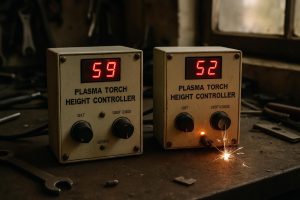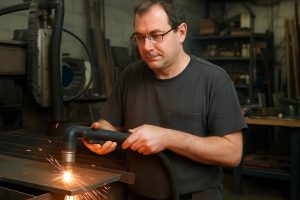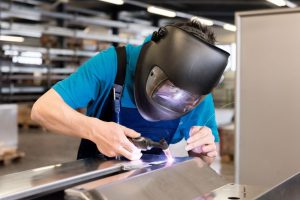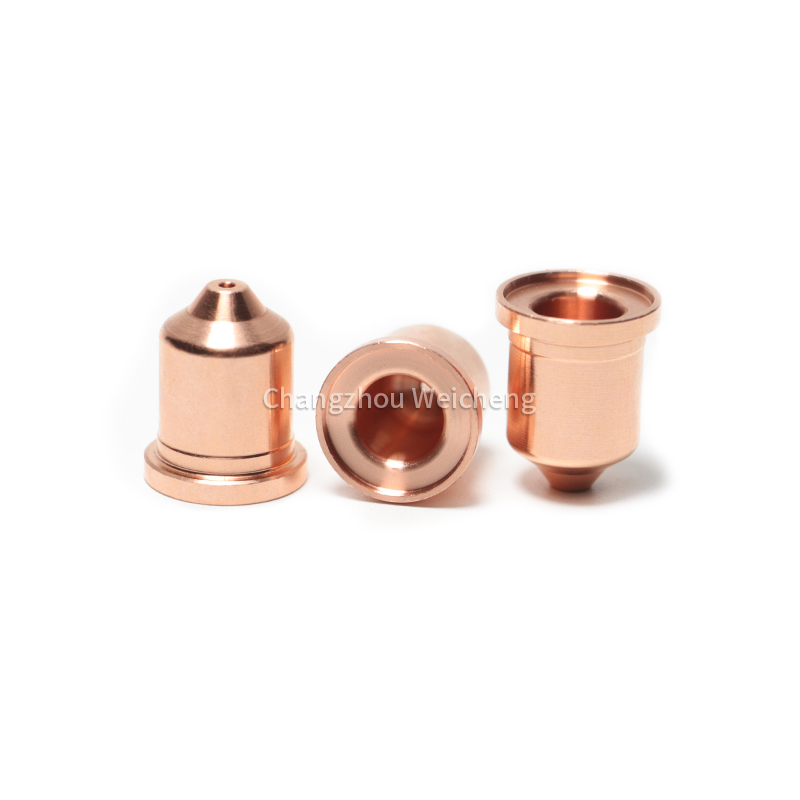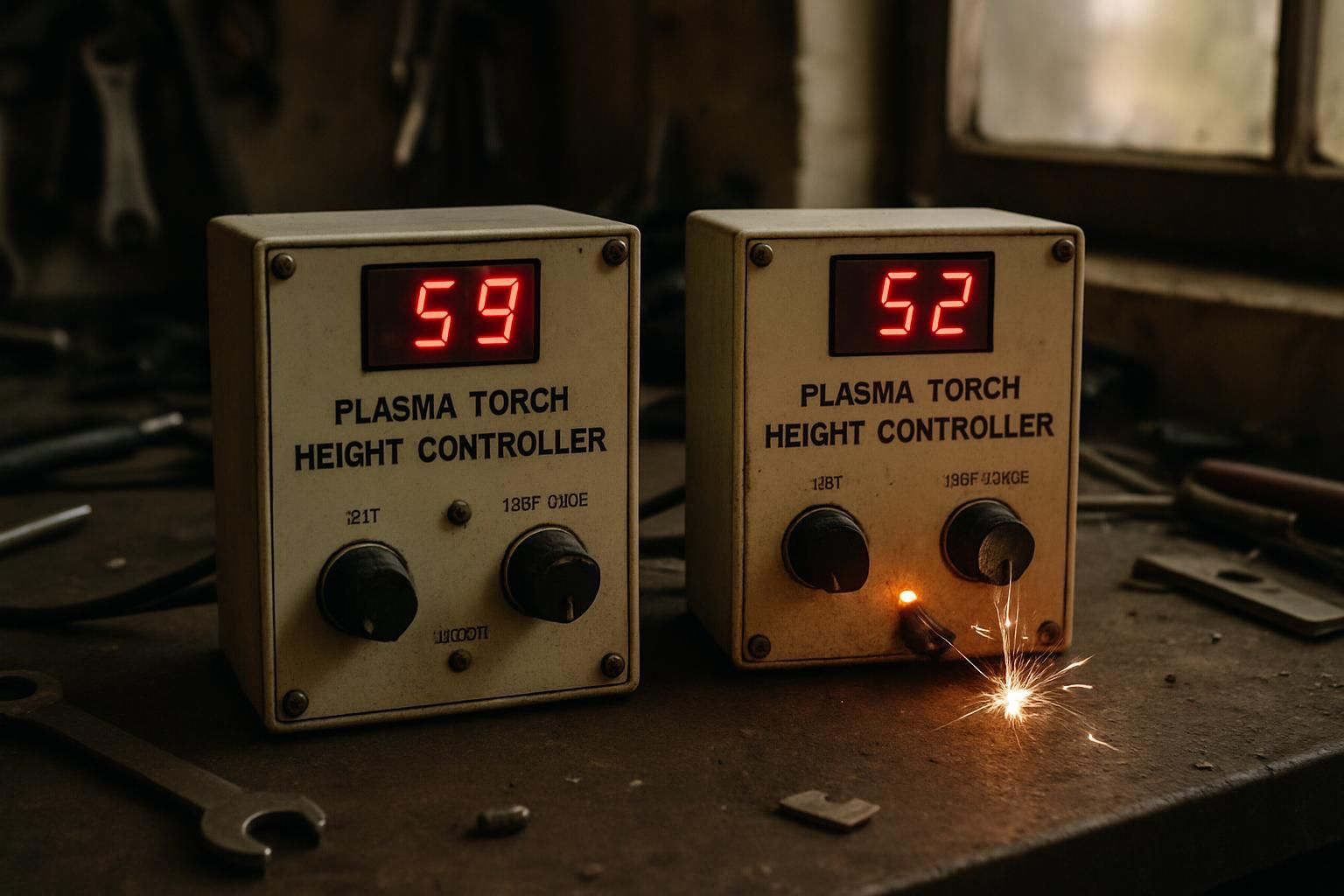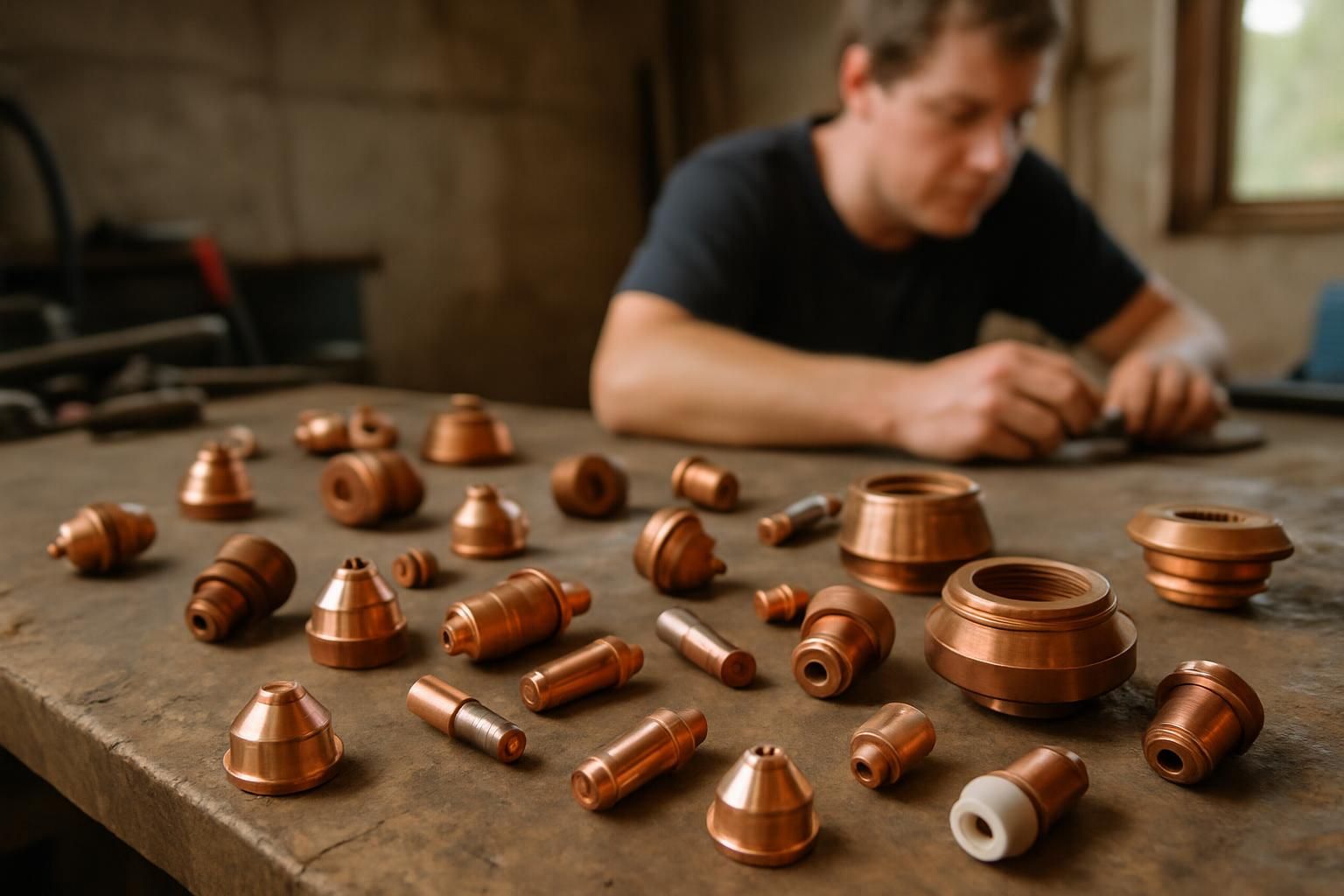Let’s dive into the world of welding! Plasma and MIG welding are two popular methods that have their own unique strengths. We’ll explore how these techniques differ and when to use each one.
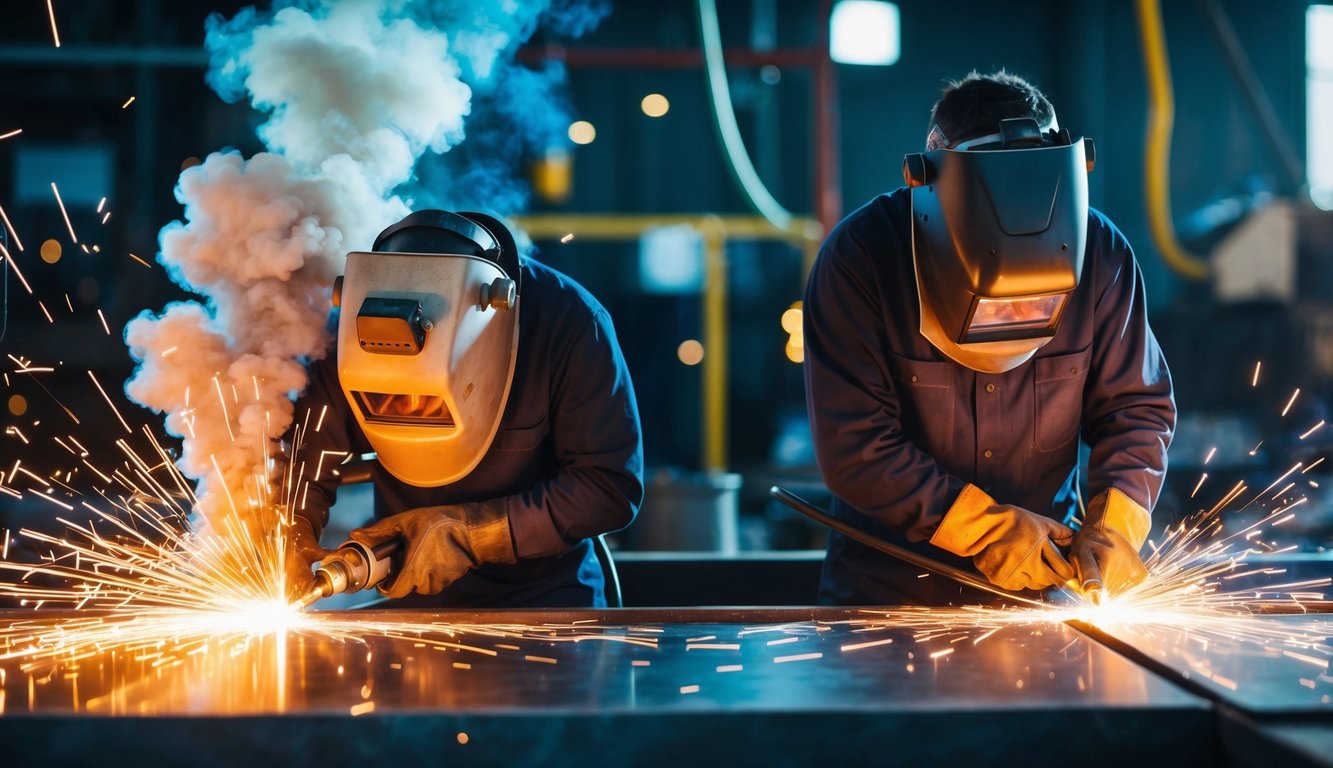
Plasma welding uses a high-temperature ionized gas to create precise, clean welds on thin materials. It’s great for jobs that need a steady hand and a keen eye. MIG welding, on the other hand, relies on a continuously fed wire electrode to join metals. It’s faster and more versatile, making it a go-to choice for many welders.
We’ll also touch on TIG and stick welding to give you a full picture of your options. By the end of this post, you’ll have a clear idea of which welding method suits your needs best. Whether you’re working on a car, building a sculpture, or fixing farm equipment, we’ve got you covered!
Understanding Plasma vs MIG Welding Basics

Plasma and MIG welding are two popular methods used in metalworking. These techniques have unique features and applications that set them apart. Let’s explore their history, core concepts, and basic setup requirements.
Brief History And Evolution
Welding has come a long way since its early days. MIG welding was developed in the 1940s and quickly gained popularity. It offered faster welding speeds and better control over the weld pool. Plasma welding came later, in the 1960s. It was created to improve upon existing arc welding methods.
MIG welding started with large, bulky machines. Over time, they became smaller and more portable. Plasma welding began as a cutting technique. It later evolved into a welding method for thin materials.
Today, both methods are widely used in industries like automotive and aerospace. They’ve become more efficient and precise with advances in technology.
Core Concepts Of Each Method
MIG welding uses a wire electrode and shielding gas. The wire melts to form the weld pool. The gas protects the weld from contamination. It’s great for joining thick materials quickly.
Plasma welding uses a non-consumable tungsten electrode. It creates a focused arc of superheated ionized gas. This plasma arc melts the base metal and any filler material. It’s ideal for precise welds on thin materials.
Here’s a quick comparison:
| Feature | MIG Welding | Plasma Welding |
|---|---|---|
| Heat Source | Electric arc | Plasma arc |
| Electrode | Consumable wire | Non-consumable tungsten |
| Shielding | Gas | Gas |
| Best for | Thick materials | Thin materials |
| Speed | Fast | Moderate |
| Precision | Good | Excellent |
Basic Setup Requirements
For MIG welding, we need:
- A MIG welder
- Shielding gas (usually argon or CO2 mix)
- Wire electrode
- Work clamp
- MIG gun
Plasma welding requires:
- Plasma power source
- Plasma torch
- Shielding and plasma gases
- Cooling system
- Work clamp
Both methods need proper safety gear like welding helmets and gloves. Good ventilation is also crucial.
Setting up for MIG welding is generally simpler. We just feed the wire and connect the gas. Plasma welding needs more careful setup. We must adjust gas flow rates and electrode position precisely.
Direct Comparison: Plasma Vs MIG
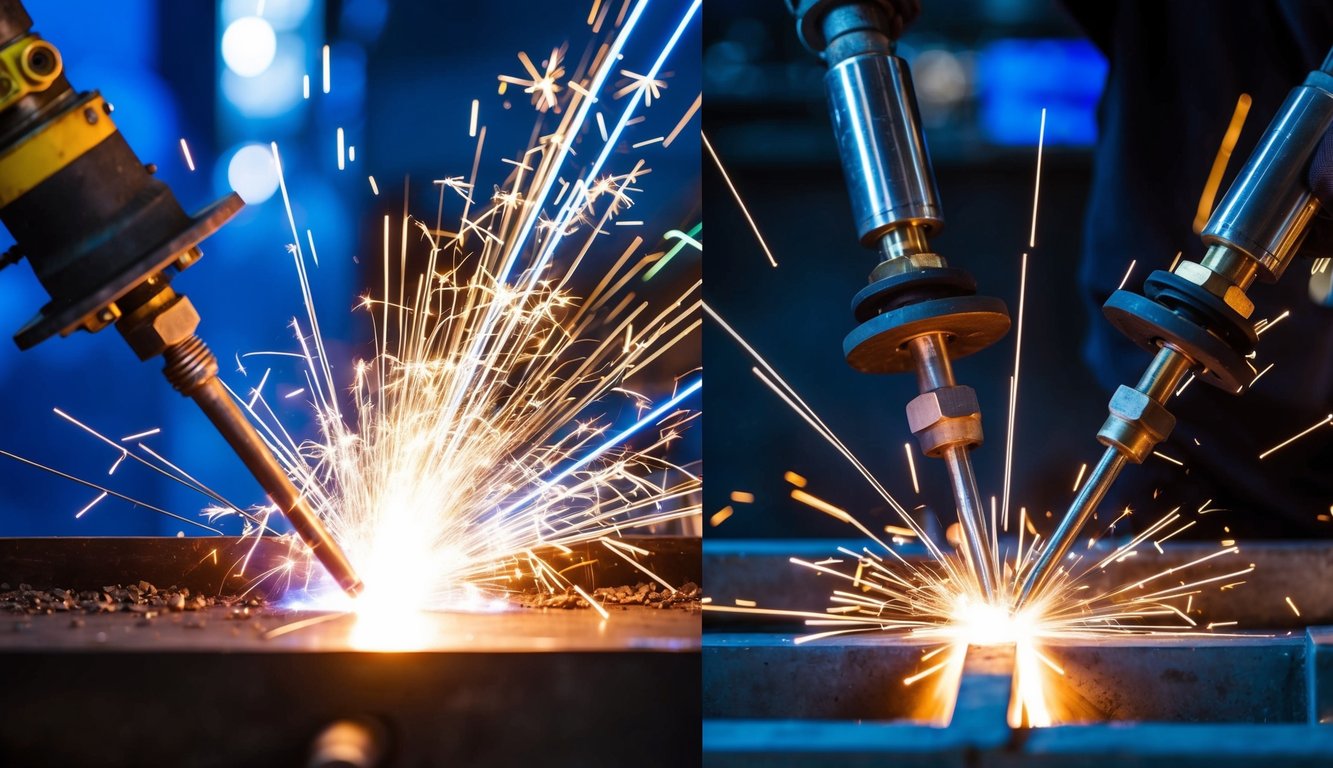
Plasma and MIG welding have distinct strengths and capabilities. We’ll explore their key differences in temperature, penetration, speed, and weld quality to help you choose the right method for your needs.
Temperature Capabilities
Plasma welding operates at much higher temperatures than MIG. It can reach up to 30,000°C, while MIG typically maxes out around 6,000°C. This extreme heat allows plasma to cut through thick metals with ease.
MIG’s lower temperature is often an advantage. It causes less warping and distortion in thinner materials. This makes it great for automotive work and other projects where keeping the metal’s shape is crucial.
We find plasma’s intense heat perfect for joining tough metals like titanium. MIG struggles with these materials due to its lower temperature range.
Penetration Depth
Plasma welding achieves deeper penetration than MIG in most cases. Its concentrated arc can pierce through thick metals, making clean, precise cuts.
MIG welding offers more control over penetration depth. By adjusting wire feed speed and voltage, we can fine-tune how deep the weld goes. This versatility is handy for a wide range of projects.
For thin materials, MIG often wins out. Its shallower penetration reduces the risk of burn-through. Plasma can be overkill on delicate work.
Speed And Efficiency
MIG welding is generally faster than plasma for most jobs. Its continuous wire feed allows for quick, efficient welds on long seams. We can cover a lot of ground in a short time with MIG.
Plasma shines in automated setups. Its precise, stable arc works well with robotic systems. This can boost productivity in large-scale manufacturing.
For manual welding, MIG is usually more efficient. It’s easier to learn and requires less setup time than plasma. This makes it a go-to choice for many workshops and DIY projects.
Weld Quality And Appearance
Plasma welding produces exceptionally clean, precise welds. Its focused arc minimizes spatter and creates a narrow heat-affected zone. This results in strong, attractive welds with minimal distortion.
MIG welding can create high-quality welds too, but it takes more skill to achieve the same level of precision. It’s prone to spatter and wider heat-affected zones.
We find plasma ideal for visible welds where appearance matters. MIG is great for structural welds that will be hidden from view.
Both methods can create strong, durable welds when done correctly. The choice often comes down to the specific requirements of your project.
Visual Comparison Diagram/Table
| Feature | Plasma Welding | MIG Welding |
|---|---|---|
| Temperature | Up to 30,000°C | Up to 6,000°C |
| Penetration | Deep, precise | Adjustable, moderate |
| Speed | Slower, best for automation | Faster, great for manual work |
| Weld Quality | Very clean, minimal spatter | Good, some spatter possible |
| Best Uses | Thick metals, precision work | Thin to medium metals, long seams |
| Learning Curve | Steeper | More beginner-friendly |
| Cost | Higher initial investment | More affordable |
This table sums up the key differences between plasma and MIG welding. We hope it helps you decide which method suits your needs best!
Making The Right Choice: Selection Criteria
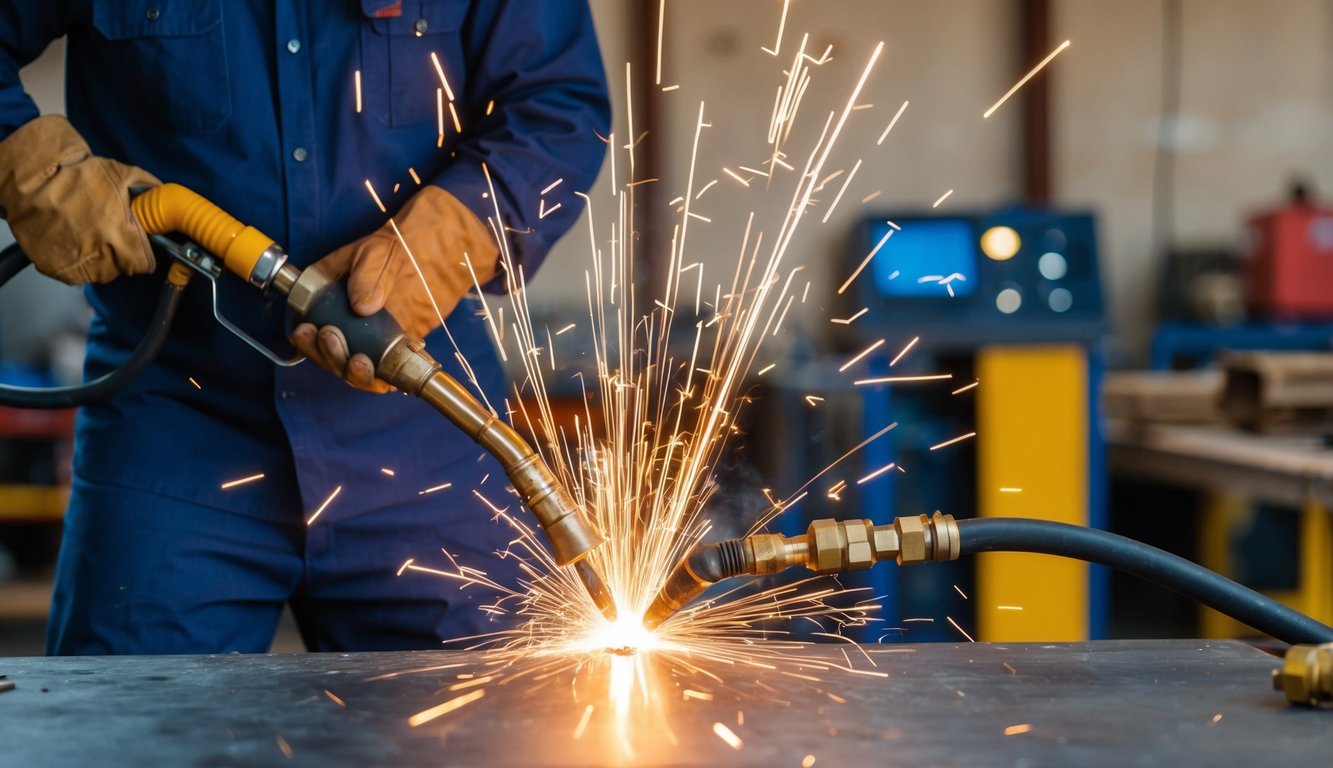
When it comes to choosing between plasma and MIG welding, several key factors come into play. We’ll explore the crucial aspects to consider, from material types to production needs.
Material Considerations
The type of metal you’re working with greatly impacts your welding choice. MIG welding shines with steel and aluminum, making it a go-to for many projects. It’s versatile enough to handle carbon steel, stainless steel, and even copper alloys.
Plasma welding, on the other hand, excels with electrically conductive metals. It’s particularly effective for stainless steel and aluminum. The intense heat of plasma can also tackle tougher materials like brass.
When dealing with metals prone to oxidation, plasma’s inert gas shield offers better protection. This makes it ideal for reactive metals that might tarnish or weaken with exposure to air during welding.
Project Requirements Analysis
Your project’s specifics play a big role in choosing between plasma and MIG. Are you working on thin sheets or thick plates? Do you need precise, narrow welds or broader coverage?
MIG welding is great for a wide range of thicknesses. It’s our top pick for sheet metal work and auto body repairs. The continuous wire feed allows for long, uninterrupted welds.
Plasma welding offers incredibly precise, narrow welds. This makes it perfect for detailed work or when you need to minimize heat-affected zones. It’s also excellent for automated welding setups.
Consider your project’s structural integrity needs too. MIG can provide strong, deep penetration welds, while plasma offers high-quality, clean welds with less risk of warping.
Thickness Capabilities
How thick is your material? This question is crucial in your welding decision.
MIG welding is versatile across thicknesses:
- Thin materials: 24 gauge (0.6 mm)
- Thick materials: Up to 1/2 inch (13 mm) in a single pass
Plasma welding has a different range:
- Thin materials: As thin as 0.1 mm
- Thick materials: Typically up to 1/4 inch (6 mm)
For very thin materials, plasma’s precision is hard to beat. But for thick structural work, MIG often takes the lead. Remember, multiple passes can increase these ranges for both methods.
Quality Requirements
The quality of your welds can make or break a project. Let’s look at how plasma and MIG stack up.
Plasma welding offers:
- Extremely clean welds
- Minimal spatter
- Reduced need for post-weld cleanup
- High-quality finish, often suitable for visible areas
MIG welding provides:
- Good-quality welds with proper technique
- More forgiving for beginners
- Ability to work in various positions
- Strong, deep penetration
For projects where appearance is key, plasma often has the edge. But don’t count MIG out – with skill, it can produce beautiful welds too.
Production Volume Considerations
Are you working on a one-off project or a high-volume production line? Your output needs will influence your choice.
MIG welding is great for high-volume work:
- Faster welding speeds
- Easier to automate
- More forgiving of slight variations in material
Plasma welding suits specialized, lower-volume needs:
- Precision work
- Thin materials
- Where weld quality is paramount
For large structural projects, MIG’s speed often wins out. But for industries needing precise, high-quality welds on thinner materials, plasma can be more efficient in the long run.
Cost Considerations And ROI
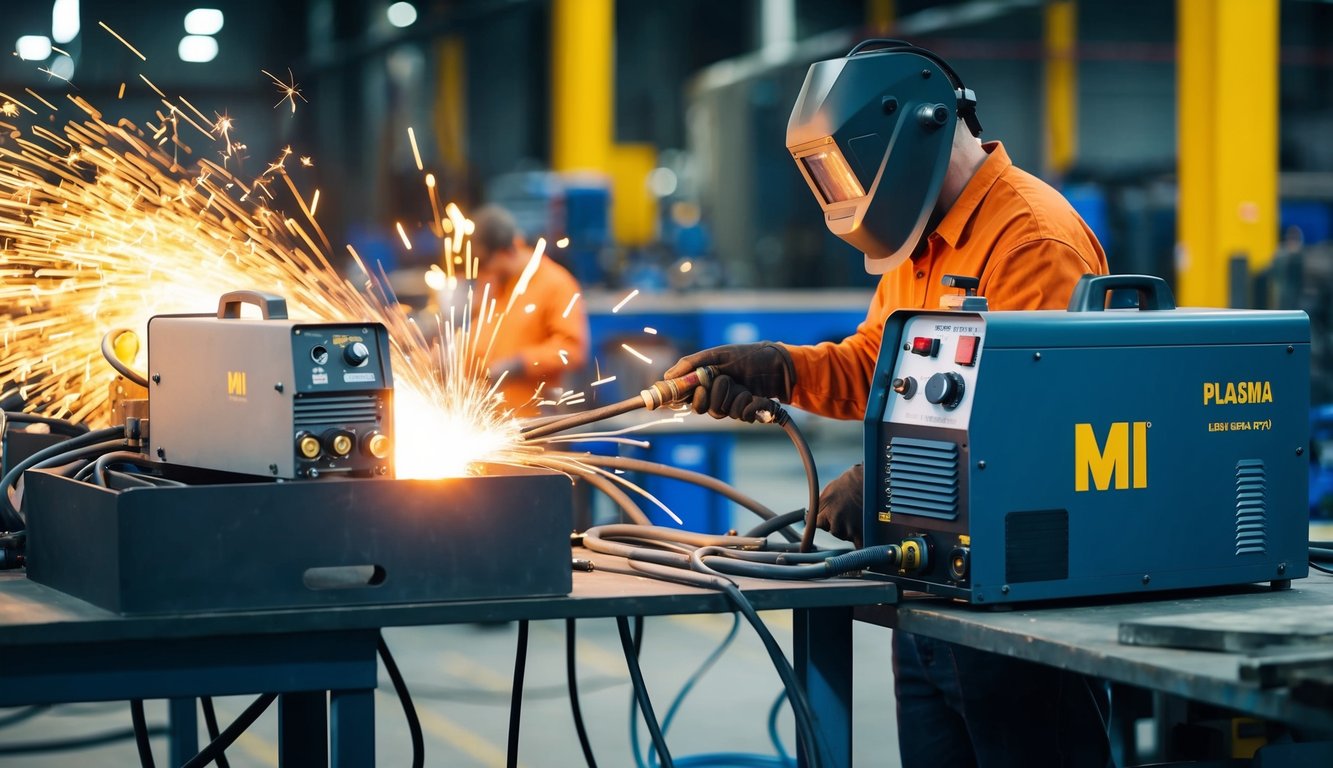
When comparing plasma and MIG welding, it’s crucial to look at the financial aspects. We’ll break down the key cost factors and return on investment considerations to help you make an informed decision.
Initial Equipment Costs
MIG welders are generally more affordable upfront. Basic MIG setups can start around $500, while professional models might cost $2,000-$3,500. Plasma cutters, on the other hand, tend to be pricier. Entry-level plasma cutters start around $1,000, with high-end models reaching $5,000 or more.
We’ve found that MIG welders are a great choice for beginners or small shops due to their lower initial investment. But don’t forget about extras! You’ll need to factor in costs for welding wire, shielding gas, and safety gear for both options.
Operating Costs
Day-to-day expenses can add up quickly. For MIG welding, the main ongoing costs are:
- Welding wire
- Shielding gas (usually argon or CO2 mixture)
- Replacement parts like contact tips and nozzles
Plasma cutting has its own set of consumables:
- Electrodes
- Nozzles
- Swirl rings
- Compressed air or nitrogen for shielding
We’ve noticed that MIG welding tends to have higher gas costs due to continuous flow during operation. Plasma cutting often uses less gas, but electrodes and nozzles wear out faster, especially on thicker materials.
Long-Term Maintenance
Both plasma and MIG systems need regular upkeep to stay in top shape. Here’s what you can expect:
MIG welders:
- Clean the wire feed system
- Replace contact tips and nozzles
- Check and adjust gas flow
Plasma cutters:
- Clean the torch head
- Replace electrodes and nozzles
- Maintain air compressor (if using compressed air)
We’ve found that plasma cutters often require more frequent part replacements, which can increase long-term costs. However, their precise cuts can reduce the need for post-cut cleanup, saving time and labor.
Production Efficiency Factors
Efficiency is key to maximizing your ROI. Here’s how plasma and MIG compare:
MIG welding:
- Faster for joining metals
- High duty cycle for continuous work
- Easy to learn and use
Plasma cutting:
- Quicker for cutting metal sheets
- Precise cuts reduce material waste
- Can cut through painted or rusty surfaces
We’ve seen that choosing the right process can significantly boost productivity. For large welding jobs, MIG often wins out. But for projects needing lots of cutting, plasma can be a game-changer.
Break-Even Analysis
To figure out when your investment will pay off, consider these factors:
- Equipment cost
- Labor savings
- Material savings
- Production speed increase
Here’s a simple break-even calculation:
| Factor | MIG Welding | Plasma Cutting |
|---|---|---|
| Initial Cost | $2,000 | $3,000 |
| Monthly Savings | $300 | $400 |
| Break-Even Time | 6.7 months | 7.5 months |
This example shows that while plasma costs more upfront, its higher monthly savings could lead to a quicker ROI. Your actual numbers will vary based on your specific needs and usage.
Remember, the best choice depends on your projects. We recommend tracking your costs and efficiency gains to make sure you’re getting the most bang for your buck.
Real-World Applications
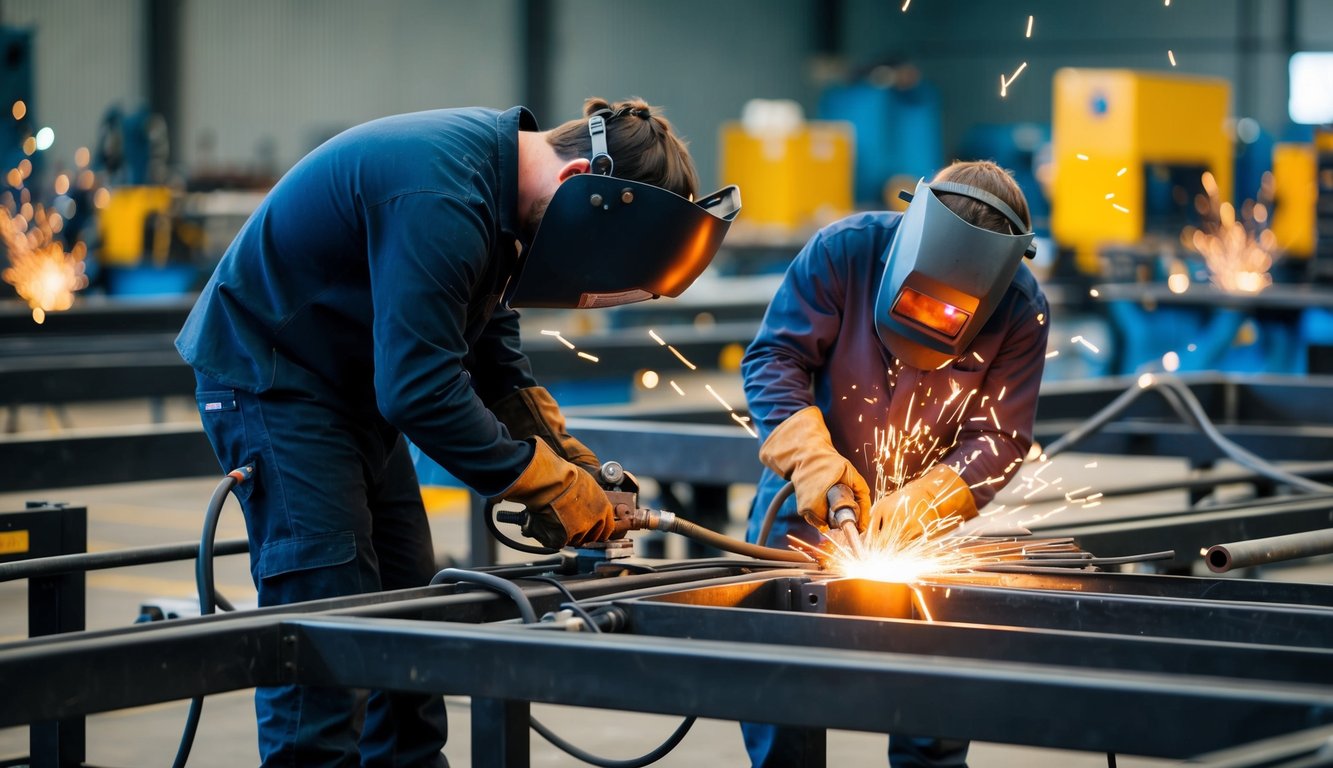
Plasma and MIG welding techniques have revolutionized metal fabrication across various industries. These methods offer unique advantages for joining metals in different scenarios.
Industry-Specific Uses
In aerospace, plasma welding shines for its precision in joining thin materials like aluminum. We see it used for aircraft components where minimal heat distortion is crucial. MIG welding, on the other hand, is a go-to in automotive manufacturing. It’s great for welding car body panels and frames.
The shipbuilding industry relies heavily on both methods. Plasma welding works wonders for cutting intricate shapes in thick metal plates. MIG welding is perfect for joining large sections of a ship’s hull.
In construction, MIG welding is widely used for structural steel work. It’s fast and effective for joining beams and columns. Plasma welding finds its niche in precision cutting of steel plates for custom architectural features.
Case Studies
A major aerospace company switched to plasma welding for fuel tank assembly. They reported a 30% increase in weld quality and a 20% reduction in production time.
An automotive plant in Detroit implemented MIG welding robots. This move led to a 40% boost in production speed and a 15% decrease in material waste.
A shipyard in Norway combined plasma cutting with MIG welding. This combo resulted in 25% faster ship construction and improved weld integrity in critical areas.
Success Scenarios For Each Method
Plasma Welding Wins:
- Joining ultra-thin sheets in electronics manufacturing
- Precision repairs in aerospace components
- Cutting complex shapes in metal art sculptures
MIG Welding Triumphs:
- Rapid assembly of automotive frames
- Joining thick steel plates in heavy machinery
- DIY projects for home welders
Common Applications Comparison
| Application | Plasma Welding | MIG Welding |
|---|---|---|
| Automotive | Precision parts | Body panels |
| Aerospace | Thin materials | Structural components |
| Construction | Custom cutting | Steel framework |
| DIY Projects | Artistic metal work | General repairs |
In infrastructure projects, MIG welding is the top choice for its speed and strength. We’ve seen it used extensively in bridge construction and pipeline installations.
For automotive repairs, MIG welding is more common in body shops. It’s user-friendly and versatile for fixing various car parts. Plasma cutting, though, is handy for precise removal of damaged sections.
Practical Considerations
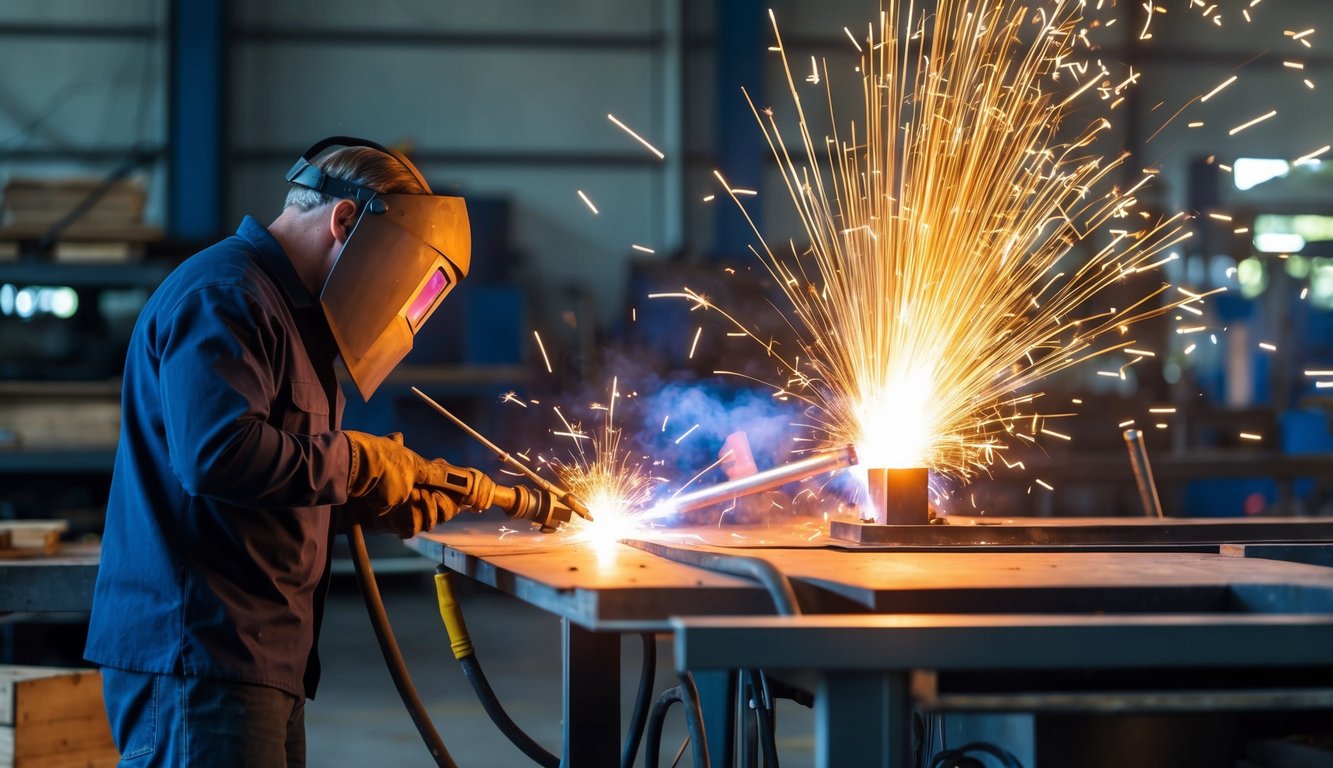
Plasma and MIG welding each come with their own set of practical considerations. We’ll explore the key factors to keep in mind when choosing between these welding methods.
Required Skill Level
Plasma welding demands a higher skill level than MIG welding. We find that operators need precise control and in-depth knowledge of plasma arc behavior. MIG welding is more forgiving, making it easier for beginners to pick up.
Plasma welding requires:
- Steady hand and eye coordination
- Understanding of complex equipment settings
- Ability to manage high temperatures
MIG welding needs:
- Basic welding knowledge
- Familiarity with wire feed speed and voltage settings
- Less finesse in torch control
For thin materials or intricate work, plasma welding’s precision is unmatched. But for general welding tasks, MIG often suffices.
Safety Considerations
Both plasma and MIG welding pose safety risks, but plasma welding has some unique hazards. We always stress the importance of proper safety gear and training.
Plasma welding risks:
- Extremely high temperatures
- UV radiation
- Electromagnetic fields
- Compressed gases
MIG welding risks:
- Sparks and spatter
- Fumes and gases
- Electric shock
- Burns
Key safety gear for both:
- Welding helmet with proper shade
- Fire-resistant clothing
- Gloves and safety shoes
- Proper ventilation or respiratory protection
We can’t stress enough the need for a clean, organized workspace to minimize accidents.
Training Requirements
Training for plasma welding is more intensive than for MIG welding. We’ve seen that it takes longer for welders to become proficient with plasma equipment.
Plasma welding training covers:
- Plasma arc physics
- Equipment setup and maintenance
- Advanced torch control techniques
- Troubleshooting complex issues
MIG welding training includes:
- Basic welding theory
- Wire selection and feed speed
- Welding gun handling
- Common joint types and positions
Both require hands-on practice, but plasma welding often needs additional specialized courses. We recommend starting with MIG welding before moving to plasma for most welders.
Equipment Maintenance
Maintaining plasma welding equipment is generally more complex than MIG welders. We find that plasma systems have more components that require regular attention.
Plasma equipment maintenance:
- Electrode and nozzle inspection and replacement
- Gas flow system checks
- Power supply calibration
- Cooling system maintenance
MIG equipment maintenance:
- Wire feed mechanism cleaning
- Contact tip and nozzle replacement
- Cable inspections
- Shielding gas system checks
Both systems need regular cleaning to prevent contamination. We always keep spare parts on hand to minimize downtime.
Workspace Requirements
Plasma welding often requires a more controlled environment than MIG welding. We’ve found that workspace setup can significantly impact weld quality.
Plasma welding needs:
- Clean, dust-free area
- Stable power supply
- Proper grounding
- Adequate ventilation for high-temperature work
MIG welding workspace:
- Less sensitive to drafts
- Standard power outlet (for smaller units)
- Shielding from wind for outdoor work
- Space for wire spools and gas cylinders
Both benefit from a dedicated welding table and good lighting. We always ensure our workspace meets safety standards for electrical and fire hazards.
Future Outlook And Technology Trends
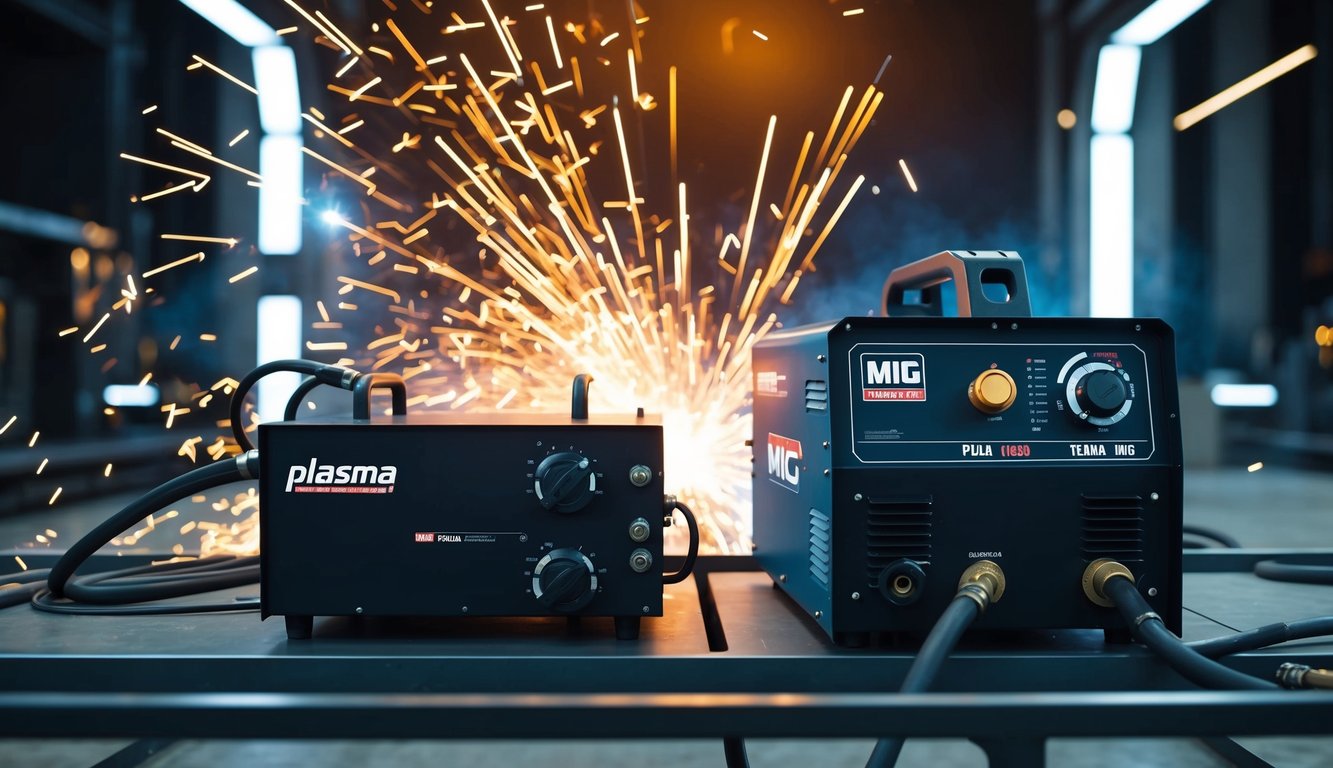
Welding is evolving rapidly with new technologies and industry shifts. Let’s explore some exciting developments shaping the future of plasma and MIG welding.
Emerging Technologies
Virtual reality (VR) and augmented reality (AR) are transforming welding training. We’re seeing VR simulators that let new welders practice in a safe, virtual environment. This cuts training costs and improves safety. AR systems can project weld paths onto workpieces, guiding welders in real-time.
Nanotechnology is another game-changer. Nano-enhanced filler metals can improve weld strength and corrosion resistance. We’re also exploring smart welding helmets with built-in sensors to monitor arc stability and weld quality.
3D printing is merging with welding too. Large-scale metal 3D printers use welding techniques to build parts layer by layer. This opens up new possibilities for complex shapes and custom parts.
Industry Projections
The welding industry is set for steady growth. We expect the global welding market to reach $28 billion by 2028. Demand is rising in sectors like automotive, construction, and aerospace.
Skilled welders are in high demand. The American Welding Society predicts a shortage of 400,000 welders by 2024. This gap is driving investment in automation and training programs.
Energy efficiency is a key focus. We’re seeing a shift towards eco-friendly welding processes and equipment. This includes power sources with improved efficiency and systems that reduce fume emissions.
Hybrid Systems
Hybrid welding combines different welding methods for better results. Laser-MIG hybrid welding is gaining traction. It offers faster speeds and deeper penetration than MIG alone.
We’re also seeing plasma-MIG hybrids. These systems use plasma for preheating and MIG for filling. This combo can boost productivity on thick materials.
Hybrid systems often need less filler metal. This cuts costs and reduces waste. They can also weld materials that are tricky with traditional methods.
Automation Potential
Robotic welding is on the rise. We estimate that 50% of welding jobs could be automated by 2030. This shift will boost productivity and consistency.
Collaborative robots or “cobots” are emerging. These work alongside human welders, handling repetitive tasks. This frees up skilled welders for more complex jobs.
AI and machine learning are enhancing automation. Smart welding systems can adjust parameters in real-time. They can detect and correct issues before they cause defects.
We’re also seeing mobile welding robots. These can move around large structures, welding in hard-to-reach spots. They’re proving useful in shipbuilding and construction.

